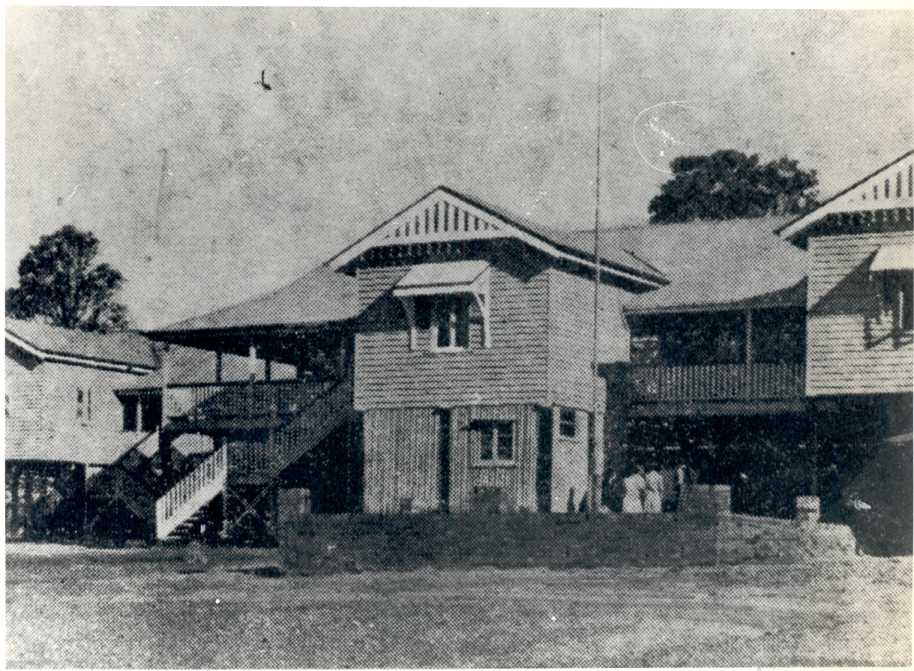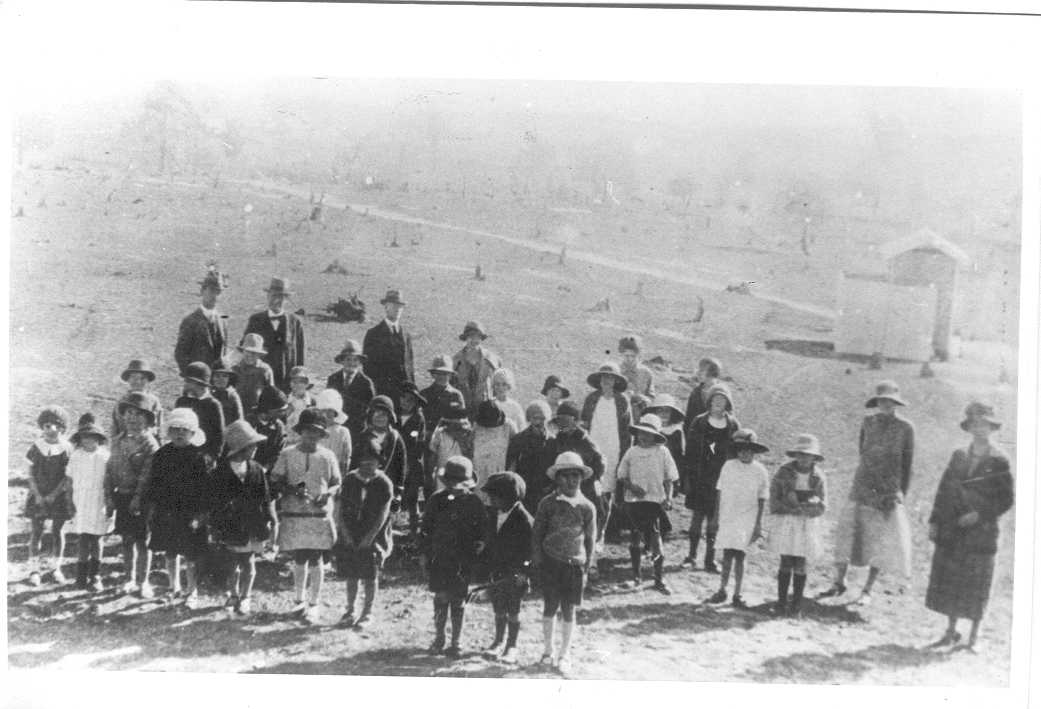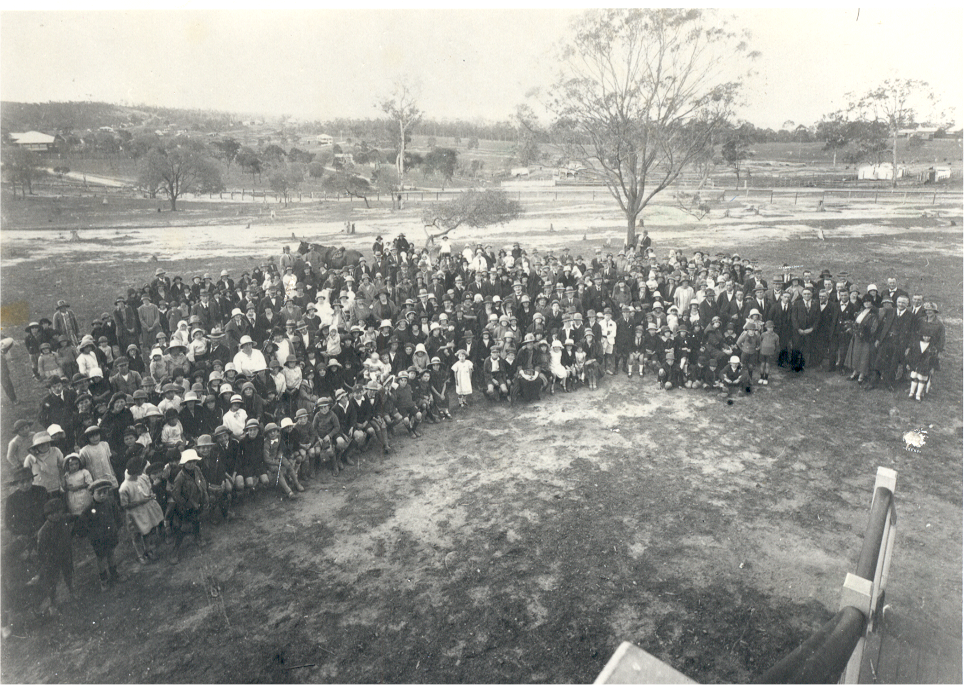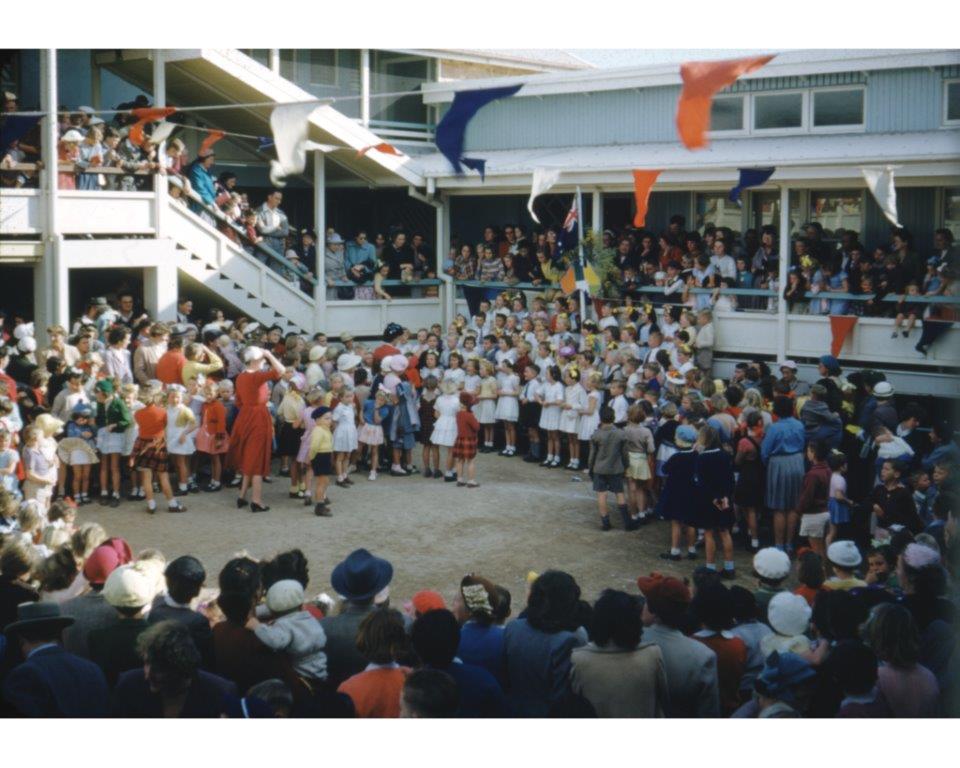As far back as 5 April 1867 a site with a total area of about 23 acres had been reserved on the Mt Bruce Housing Estate for school purposes. In October 1923 a mother of four wrote to the Department of Public Instruction (now Education Queensland) to ask them to consider building a school on the Mt Bruce site as small children were reported to be walking up to 20 miles (32 kilometres) per week to and from school.
Following two public meetings, a school Building Committee was established with ‘An Application for the Establishment of a State School’ signed on 6 October 1923 by all the members of the committee. A petition signed by interested parents living within a one mile (1.6 km) radius of the school site and indicating the number of children and their ages was also forwarded to the Department of Public Instruction.
There were by now a number of housing estates within this 1.6km radius. These included Camp Hill on the southern side of Old Cleveland Road, Mt Bruce on the northern side, Hillcrest, National Park which included Macrossan and McIllwraith Avenues, Silver Bell near Mt Bruce, City View back from Old Cleveland Road near the Camp Hill Hotel site, Ravensborne, Wotton, Prouts Hill, Windsor, and Daly. The Mt Bruce Estate roughly enclosed an area from Ferguson Road (or Eight Mile Road as it was known as then) along Old Cleveland Road to around Pampling Street and as far back as Oateson Skyline Drive.
By 1925 the Coorparoo area was enjoying a lengthy period of rapid development with houses going up at the rate of one a day. The enrolment at the Coorparoo State School was 1068 pupils with Norman Park and Carina State Schools also experiencing cramped conditions. The Camp Hill area, as it later became popularly known as, was expected to experience a similar boom. Practically all the housing blocks in the area had been sold and the tram line to Bruce Street was now operational.
On 29 June 1925 the District Inspector, Mr A Mulch, met the Building Committee, the parents and about half the number of children expected to attend the new school if it were built. A school for 120 pupils was recommended despite the Committee’s pleas to reconsider a school for 500 children. It was also suggested by the Building Committee that a road be established connecting up all the blind streets on the Mt Bruce Estate which would also give access to the school reserve and the school itself when it was established. The name Theodore Avenue was suggested. The approval of a one chain road was first received on 29 April 1926 after surveying had been completed. Theodore Avenue only went as far as the Belmont Railway near Halland Terrace despite suggestions that it meet up with Ferguson Road. It did however open up Henderson, Lewis and Donald Streets.
The school building was started on 19 November 1925. The area was bounded by Theodore Avenue (now Wiles Street), the Old Cleveland Road and Ferguson Road. The vacant land ran down to the Belmont Rail line which is now the current site of the Junior Campus. The area of land belonging to the school was 13 acres 31 perches.

The Mt Bruce State School (our school) was completed on 23 June 1926 at a cost of 2,023 pounds. It contained three classrooms (each 21 feet by 18 feet), a verandah and a teachers’ room. Two 1,000 gallon tanks were situated one either end of the building with hat and cloak rooms located under the school. Toilets (thunderboxes/outdoor dunnies) were also provided at a distance from the school buildings as photographs show. There was a short delay waiting for desks and forms (the long stools that children sat on) so the school did not actually open until Thursday, 1 July.
At 9.30am on that day the first school bell was rung. By this time eleven pupils had been enrolled. During the day more pupils arrived so that by the end of the first day fifty pupils were now on the roll. Four more desks and forms as well as another blackboard were needed to cater for extra enrolments by July 23.


The first day teaching staff consisted of Mr Robert L Morrison (Head Teacher), and two assistant teachers – Miss Margaret Smith and Miss Evelyn Harvey. Another teacher, Miss Eva French, was appointed on 16 August with this class being taught in the teachers’ room as enrolments had reached 130 by 15 July.
One of the first working bees at the school cleared the school grounds of stumps and saved the $40 (twenty pounds) raised for this purpose. This paved the way for the future development of our sports grounds. By December 14, 1926 fencing around the school grounds was completed as swagmen had been taking advantage of the ease of access to the school, using the conveniences and camping on the school verandah.
It is interesting to note some of the recollections from those early pupils. Girls remember having their plaits tied to the slate racks by the boys and both boys and girls receiving ‘the cuts’ (a hit from a bamboo cane onto the hands) from some teachers.
Apparently Thomson’s Shop (Kid’s Corner) was a favourite place for buying broken biscuits and a large quantity could be purchased for threepence (about 2 cents). For the school fete one of the parents would take a horse and sulky to South Brisbane to cadge a bag (quite large) of flour and anything else she could obtain from the retailers on the way. Miss Smith, the teacher, would help make sweets at the house of one of the parents. The daughter of the house (a school student) would take the sugar home in a hand cart but was never allowed to take the sweets back to school! (I wonder why?)
The fetes themselves were something to remember with the usual cake and sweet stalls but also the hand-made arts and crafts with goods like fancy work and aprons. The favourite item though was The Greasy Pig Event where a pig that had been oiled or greased all over was let loose and had to be caught.
In June 1930 the Camp Hill Progress Association who held their meetings at the school wrote to the School Committee suggesting a name change for the school from Mt Bruce to the more popular Camp Hill. They claimed the name, Mt Bruce, was misleading as the local post office, churches, police station and even the trams carried the name, Camp Hill – the name commonly given to the area. The Progress Association itself had recently changed it's name from Mt Bruce to Camp Hill for the above reasons. There were no objections and on May 6 1931 the Director of Education approved the name change to Camp Hill.
This same Progress Association had the School of Arts established. It was opened on Saturday, 9 March 1940 on a half acre of the school grounds and doubled as school rooms for two infants classes when overcrowding again became a problem in 1946.
Past pupils who attended our school in the 1930s recall riding to and from school on horses which were tied up behind the then tennis courts - now the Ferguson Road car park. Later still, during the war years, other past pupils recall wearing identification tags around their necks and practising air-raid drills. The boys had dug the trenches on the oval (an unenviable task knowing the nature of the ground). A ‘captain’ aged about ten years or so was appointed to be in charge of a particular trench. He had the responsibility of leading 6 -8 smaller children to the trench and making them crouch in it for some time. Despite the seriousness behind these activities the children thought the air-raid drills rather fun.
By 24 September 1945 the school consisted of two wings of three classrooms and one wing of five rooms. The grounds had been levelled for an oval approximately 180 yards by 180 yards and top dressed. A basketball (netball) court had been formed. The tennis court had been reformed with drainage added and lights were included in the school buildings.
In February the following year another wing with three classrooms was approved but by March severe overcrowding meant there were four classes without rooms. One class was taught on a verandah and the other three had lessons under the buildings. Army huts were brought in to ease the overcrowding and three western verandahs were weather-proofed against severe draughts. By December 1949 four more classrooms were added.
A proposal for a school library under an existing building on 21 September 1950 saw the establishment of our Library costing $510 (about 255 pounds) with $200 (one hundred pounds) more spent on furniture. (If only we could do the same today!)
At the end of 1950 there were now fourteen permanent classrooms and five temporary ones with the enrolment having reached 1.250. The area of the school grounds was 12 acres, 1 rood, 16.2 perches.

A separate Infants’ School was opened in 1951 (just across the oval) but it did little to put a dent in the growing number of enrolments and the need for more classrooms. By December 1952 three more classrooms were added and by 1957 another twelve temporary and nine permanent classrooms were needed to house the 1,753 pupils now attending Camp Hill.
The school’s frontage to Old Cleveland Road was levelled in 1960 and a concrete wall topped by a chain wire fence was constructed by the Works Department. May 1960 also saw the official establishment of the Swimming Pool Fund with a donation of $1,000 from the P&C Association. The ultimate goal was to raise $18,000 in three years. As far back as 1934 enquiries had been made into the feasibility of building a swimming pool. Envelopes had been sent home with the eldest asking for donations even during World War II while past pupils recalled erratic and not too frequent visits to the Coorparoo State School swimming pool.
The following two and a half years saw a period of intense fund raising activities which included raffles, bottle drives, Operation Door Knock (September 1960), Carols by Candlelight (December 1960), two fetes (May ’61 and October ’62), a Miss Sports Girl Quest (November 1961) and, of course, $10 donations from parents. The result being that $18,112 was raised. A grandstand to seat 500 people, floodlighting, turfing, tiling and concrete works to the value of $5,506 were authorised.
However, nine days before the official handover date of 18 February 1963, a disastrous fire destroyed all the central classrooms.
Saturday 9 February 1963 saw at least 13 rooms destroyed. These included the Head Teacher’s office, staff room, stockroom, storerooms, library and health room. Other sections were considerably damaged with heavy loss of school equipment such as the school records and musical instruments.
It took twenty firemen to control the blaze which they had under control in less than an hour but by then about £20 000 ($40 000) damage had been sustained. The thirty plus metre flames attracted around 2,000 spectators who hampered firemen and police but many of the people pitched in to help save a refrigerator from a downstairs room and to empty classrooms of furniture and fittings. The blaze was attributed to an electrical fault.
On resuming school the next week, Year 3 children were accommodated in four rooms used for dancing and similar activities in the Infant School while the other children went to eight rooms in the Primary School. Apparently while the rooms were being furnished by workmen a Telegraph (newspaper) reporter came across a class being taught in the shade of a Poinciana tree near the oval (behind where the girls’ toilets have since been built.) and dubbed it “ the Tree of Wisdom”. Sadly, our “Tree” was given the ‘chop’ later when it was found its roots were interfering with the plumbing for the toilets.
After the fire the new classrooms were ready for occupancy by 22 July. Although the children had already been using the pool since 18 February, the Official Opening was not conducted until later in the year on 19 October. The pool was not heated at this time. Heating of the school swimming pool did not occur until 1996.
Almost a year later on 26 September 1964 the new Administration Block was opened by the Hon. T.A. Hiley. This area has now been remodelled several times over but still houses the main reception facilities and the front door of the school off Old Cleveland Road.
In 1981 on 13 October the Camp Hill-Belmont R.S.L. completed construction of their Memorial dedicating our Native Tree Plot near the parade ground. Since then A.N.Z.A.C. day marches from the Camp Hill hotel conclude at the Memorial. The children are encouraged to march and participate in the ceremony including the laying of wreaths.
In 1983, with money raised through a lamington drive, the stumps on the old Army Hall that was used as a TV room and for Physical Education on wet days were replaced. However, only eight years later in 1991 this old hall was condemned and the cost of repair was such that it was considered a better alternative to demolish it and form what is now the western car park – where the Principal and other Administrative Staff park.
1984 saw the extension to the school library completed. A small alcove used as a year 6 eating area located between the music room and the library was converted to a library workroom and extension. A courtyard on the Old Cleveland Road side was also constructed with the principal, Mr Vic McKay donating a small pond. However, with the considerable traffic noise and the fact that it received full sun in summer – making it very hot – and no sun in winter – making it freezing with the wind – the courtyard was a good idea but not very practical.
Disaster in the form of a fire struck again on 16 October 1988. This time the cause was arson. A young man who had never attended the school was later arrested and charged with starting the fire that destroyed the top of ‘C’ block and caused smoke and water damage to the lower section. The entire top of ‘C’ block was rebuilt and ready for use in 1989. As a precaution a fire retardant ceiling was built in the library.
1992 saw the establishment of the Outside School Hours Care program with the facility being set up in Room 26. This was later extended to Room 25. The facility now occupies the School of Arts Hall.
1993 saw the school uniform changed to include culottes for girls though still in the blue, brown gold, white check. Our new school uniform did not come into being till much later with the amalgamation of the two campuses.
A Special Education Class was established in 1996.
23 June 1926 - Mt Bruce State School completed
1 July 1926 - Mt Bruce State School officially opens